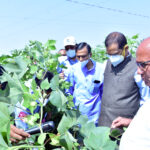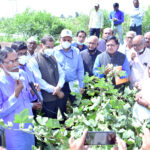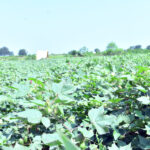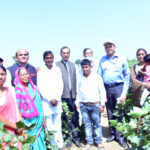Dada Lad Cotton Production Technology
India is one of the largest producers of cotton in the world accounting for about 26% of the world cotton production. Cotton yield is presently 459 Kg/ha is still lower against the world average yield of about 757 Kg /ha. Although Maharashtra has the highest area under cotton with 41.84 lakh hectares, the average 350 kg/ha yield is the lowest among all states.

Dada Lad Cotton Production Technology
In cotton, lateral branches are produced from the axils of the leaves of the main stem. There are two types of branches i.e. vegetative (monopodial) and reproductive (sympodial), the latter bears the bolls. Vegetative (monopodial) branches are structurally similar to the main stem and arise from the main stem near the ground and grow in an upright position. The number of vegetative branches depends primarily on the environment and plant spacing. Sympodial branches develop from buds on the main stem and are defined by the presence of floral buds (squares), flowers and fruits.
The saga of Dada Lad Cotton Production Technology
 A devoted social worker Shri. Dada Lad, Organization Secretary of Bhartiya Kisan Sangh, Maharashtra and Goa state has a keen interest in cotton production, due to his association with the crop from childhood as cotton was the cash crop for his family livelihood. Therefore, he always bears a special bonding with cotton and whenever he comes across any agro-technology, he tries to extrapolate it in cotton. About 15 – 16 years ago while on tour for organizational work of Bhartiya Kisan Sangh, he was in a banana orchard. He observed that the farmers were removing the pseudo-stems. Upon enquiry, it was revealed to him that these lower branches are vegetative only and do not bear reproductive growth. Also, if left un-cut, it takes major nutrients and the ultimate yield is decreased.
A devoted social worker Shri. Dada Lad, Organization Secretary of Bhartiya Kisan Sangh, Maharashtra and Goa state has a keen interest in cotton production, due to his association with the crop from childhood as cotton was the cash crop for his family livelihood. Therefore, he always bears a special bonding with cotton and whenever he comes across any agro-technology, he tries to extrapolate it in cotton. About 15 – 16 years ago while on tour for organizational work of Bhartiya Kisan Sangh, he was in a banana orchard. He observed that the farmers were removing the pseudo-stems. Upon enquiry, it was revealed to him that these lower branches are vegetative only and do not bear reproductive growth. Also, if left un-cut, it takes major nutrients and the ultimate yield is decreased.
Immediately he correlated it to the cotton crop where monopodial branches become thick than sympodial branches. He decided to implement the concept of removal of vegetative branches and started an experiment in a farmer’s field. He also made an intervention of promoting lateral branches by de-topping. The results were overwhelming.
The number of bolls per plant and boll weight significantly increased just be by removing monopodial branches after 40- 45 DAS. Encouraged by the results he convinced a group of farmers to adopt this experiment in the vicinity. Farmers who adopted also got convinced that a meagre intervention would give back a significant yield increase.
Details of Technology
- Removal of monopodial branches at 45-50 DAS
- De-topping of cotton plants
One of the most interesting observations was that the removal of monopodial branches and de-topping of cotton plants resulted in a large accumulation of assimilates in the root system, which indicates that there is an increase in the flow of nutrients to the sinks and consequently more assimilates towards the old bolls or for initiating new and additional bolls.
This combination practice also resulted in better light penetration into the plant canopy, increased air circulation among plants resulting in an improved CO2 supply for photosynthesis, lower humidity, and a reduction in the amount of boll infestation on early set fruit. The overall effect of this technology is an increase in boll weight and the number of bolls, resulting in increased seed cotton yield. Technology has been immensely popularized in the last couple of years. At present more than 700 farmers with 1600 acres from Vidarbha and Marathwada has adopted this technology.
Recently scientific experimentation has been initiated at KVK, Nandurbar (MS). However, it is requested that the technology may be improvised further with its implementation through state and central govt. agencies in the interest of cotton growers. The results of the technology at farmers’ field are as follows:

DG Discussing with owner farmer
1. Name of farmer: Shri. Rameshwar Ambhore
Village: Sipora-Abhora, Tq.: Jafrabad.Dist.: Jalana
Date of sowing: 30 May 2020
| Treatments |
Spacing (ft) |
Removal of monopodial(DAS) |
Detopping (DAS) |
No.of sympodial |
No. of bolls/plant |
Avg.weight of boll(g) |
Seed cotton yield (q/acre) |
| Farmers practice |
4×2 |
– |
– |
14 |
62 |
3.2 |
8.5 |
| Dada Lad Cotton Production Technology |
3×1 |
45 |
90 |
10 |
50 |
6 |
33.5 |
- 10-15% yield loss was observed due to boll rot (unseasonal rains).
2. Name of farmer: Shri. Kishor Chavhan
Village: Nimkheda Tq. Jafrabad.Dist.: Jalana
Date of sowing: 2 June 2020
| Treatments |
Spacing (ft) |
Removal of monopodial(DAS) |
Detopping (DAS) |
No.of sympodial |
No. of bolls/plant |
Avg.weight of boll(g) |
Seed cotton yield (q/acre) |
| Farmers practice |
4×2 |
– |
– |
14 |
59 |
3.1 |
8.2 |
| Dada Lad Cotton Production Technology |
2×1 |
45 |
60 |
6 |
20 |
6 |
18.6 |
| Dada Lad Cotton Production Technology |
3×1 |
45 |
90 |
10 |
50 |
6 |
32.4 |
- 10-15% yield loss was observed due to boll rot (unseasonal rains).
From the above results, it is seen that with the adoption of an improved method ( Dada Lad technology ) seed cotton yield, as well as some yield components, were increased as compared with the farmer’s practice. The yield was increased in the range of 295 % in the spacing of 3×1ft, and 126% in the spacing of 2×1 as compared to farmers practice (4×2ft ).
-

-
Dada Lad Cotton Production Technology
-

-

-

-

-

-
The saga of Dada Lad Cotton Production Technology https://bharatiyakisansangh.org/2021/10/dada-lad-cotton-production/
-

-

-

-

-

-
Dinesh Kulkarni, Organization Secretary, Bhartiya Kisan Sangh
-

-

-

-

-
DG Discussing with owner farmer
-

-

-
Dr. T C Mahapatra addressing, DG ICAR











 A devoted social worker Shri. Dada Lad, Organization Secretary of Bhartiya Kisan Sangh, Maharashtra and Goa state has a keen interest in cotton production, due to his association with the crop from childhood as cotton was the cash crop for his family livelihood. Therefore, he always bears a special bonding with cotton and whenever he comes across any agro-technology, he tries to extrapolate it in cotton. About 15 – 16 years ago while on tour for organizational work of Bhartiya Kisan Sangh, he was in a banana orchard. He observed that the farmers were removing the pseudo-stems. Upon enquiry, it was revealed to him that these lower branches are vegetative only and do not bear reproductive growth. Also, if left un-cut, it takes major nutrients and the ultimate yield is decreased.
A devoted social worker Shri. Dada Lad, Organization Secretary of Bhartiya Kisan Sangh, Maharashtra and Goa state has a keen interest in cotton production, due to his association with the crop from childhood as cotton was the cash crop for his family livelihood. Therefore, he always bears a special bonding with cotton and whenever he comes across any agro-technology, he tries to extrapolate it in cotton. About 15 – 16 years ago while on tour for organizational work of Bhartiya Kisan Sangh, he was in a banana orchard. He observed that the farmers were removing the pseudo-stems. Upon enquiry, it was revealed to him that these lower branches are vegetative only and do not bear reproductive growth. Also, if left un-cut, it takes major nutrients and the ultimate yield is decreased.














